I have something really special to share today—an interview with Lorna and Jill Watt, the yarnbombing geniuses behind Knits for Life!
Not only is this an interview with two yarn artists who astound me with their large-scale and very original projects, it comes in the form of a transcribed conversation between Lorna and Jill. Having a conversation in response to my questions was their idea, and I think it really captures their personalities so much better than a written interview ever would have. (See, I said they were geniuses!)
I’ve decided to post the interview in full because it’s just too much fun!
Anna: You each got into knitting and crochet around the same time, but separately, right? What were each of your motivations to give these crafts a try?
Jill: My friend knitted a toy and I was like “that’s cute, I can do that.” I decided to try Barbara Prime’s Fuzzy Mitten Lamb.
Lorna: The one with no nose?
Jill: It had a nose, but it’s coming apart. But not because I knit it badly! Because there was a bug.
Lorna: Because it was so good the bug wanted it.
Jill: Yeah! “Num num num num num,” said the bug.
Lorna: That’s pretty good, that’s not a beginner project! Most people start with something like a scarf.
Jill: I bought a booklet with needles and a stitch holder at the craft store. I bought the pattern online. It only had knit, purl, and make one. Every row I’d be like, “oh I forgot how to knit.” And then the next row, “oh I forgot how to purl.” And then knit again. I had to re-teach myself how to do it every row for like the whole damn thing! I didn’t even give a hoot that I was incorrectly using the contrasting yarn to seam. But I noticed, at least! There are some make one increases, which even as someone who knows how to increase now, I think are the worst. I didn’t know what they were talking about!
Lorna: Why didn’t you just YouTube it?
Jill: I did! It didn’t help. I couldn’t see that in my knitting. So yeah, I made that. And it was cute. So, I kept doing it. I like making cute things like toys and accessories because they’re easy. I like fast and easy things.
Lorna: You like fast and easy because you’re a finisher.
Jill: Yeah, I’m a finisher. I didn’t want to work on something that would take a long time. But now I like having a long-term project and fast projects. I have my Beekeeper’s Quilt in the background while we do all our projects. What about you? You motivated me to learn to crochet. You and amigurumi.
Lorna: I remember we learned crochet from library books as kids. Mom knew how but mostly forgot so only helped a little. Soon I improvised a Kermit finger puppet—it was the best! I wish I still had it. After high school I started a baby blanket but didn’t finish it. Later in college when I lived in Tuebingen, Germany they had the cutest yarn shop. Like most people I’d go in and be like “squee!” and buy the yarn. Then you’re like what the heck am I gonna make with it? I made practical stuff for friends and family. I saw one friend again recently and he still had his hat, ten years later! It was all pretty ugly.
Jill: That’s the difference between us. You started out making things for other people. And I was like “I just want to make it all for myself!”
Lorna: Cuz you want to make cute things and I just want to make.
Jill: Well, I want to make, but I don’t think it will be appreciated as much as it deserves to be appreciated. The first group I joined on Ravelry is called Selfish Knitters.
Lorna: I lived where it was cold, so I made warm things for people. I had culture shock, it was cold, and I either liked to study, party, or be by myself. Ten years later in Michigan in grad school, same thing! I was in a cold place, there were yarn shops, and I would stress out. So crochet was a way to check out and do something else. Apparently I crochet when I don’t want to be engaged with the outside world, but want to do something. That whole thing about knitting for mental health; I didn’t want the things, I just wanted to do it. I didn’t know how so I watched YouTube to make hats. Pretty soon I had ideas I wanted to try. I tried selling things for the longest time. In the beginning I was really good at making weird hats and they sold instantly on Etsy because people really like unique things on there. Once I started using patterns for hats that were more structured and conformist, people didn’t want it anymore. Then you came to visit. Did I teach you to crochet? How did you learn?
Jill: I learned to crochet in Canada when I was bored. Again, out of boredom!
Lorna: That’s why people are saying we all need to be bored more.
Jill: Yeah, but we’re never bored because we have screens all the time.
Lorna: You don’t have those moments where you’re like, “arg, I have to do something!” You just scroll Twitter or Instagram instead. You taught me to knit when you visited me in grad school.
Jill: And then you re-taught yourself the wrong way and for the longest time you would twist the stitch! Like when I learned to crochet and for the longest time I couldn’t tell the difference between the front and back of the stitch.
Lorna: Oh yeah! Then I taught myself continental style. I wanted to knit faster so I looked up how the world record holder speed knits. I spent days simultaneously watching her in YouTube videos on the computer and Torchwood on the TV. Now sometimes when I knit I still have Torchwood flashbacks.
Anna: Describe the moment when it hit you that the two of you should collaborate with yarn bombing. Do you feel that you bring different skills to the process?
Lorna: It didn’t ever really hit us. But it did hit me when I was miserable in grad school that I should quit and live like Jill, doing what I want, making stuff, and figure out how to make myself happy. I remember thinking “Jill has that life. I want that life.” It wasn’t that I didn’t want to do anything. It was “I don’t want to do this, and I want the space to do something else and to figure out what it is.” I’m really lucky my husband believed in and supported me and gave me the opportunity to find out. I couldn’t have done it otherwise.
Jill: We didn’t do much together until we started yarn bombing. Why did we start yarn bombing?
Lorna: We always liked street art. In Germany my camera was always full of street art. Then in Michigan just five months after Instagram launched I was the only one hashtagging cool graffiti on campus. When we saw yarn bombing it hit us: we can do street art with yarn! Some early works by our favorite yarn bombers Ishknits and Hanasaurusrex inspired us to see yarn bombing as another kind of project just like making a toy or an accessory.
Jill: You wanted to knit for other people without selling stuff. And I Iike making things cute. Yarn bombing lent itself to both. You like graphic styles and I like cute stuff so we blended them in big projects. Except when I was teaching knitting at summer camp. You would get bored so you did string art on fences.
Lorna: See, boredom is good for creativity again.
Jill: When we’re designing a yarn bomb we work well together and complement each other’s skills. Two heads are better than one: you have someone to bounce your ideas off of and improve them.
Lorna: Everyone can get bogged down in certain ways. Usually another person won’t get bogged down in the same ways. For example, if I’m having tunnel vision thinking I have to chart out a whole project first, you might see a way to skip that and get started. So we keep each other going. I like doing conversions. You check my math. I make stupid mistakes, like I’d accidentally make a whole project a foot too narrow and drop a stitch every fifth row. You catch the mistakes. And crack the whip. I’m free labor and I make the cookies.
Jill: You crack the whip too!
Lorna: We’re just lazy so we make each other do stuff.
Jill: We hold each other accountable.
Lorna: Yeah, that’s the right way to put it.
Anna: And what made you think to try turning yarn bombing into a business? That seems like a big step!
Lorna: We like to do a really good job and focus on little details. Also, you’re really good at photography. I had learned a lot about search engine optimization and keywords while selling things on Etsy. We applied all these to our yarn bomb posts, making them engaging and easy to discover online.
Jill: People found them and started asking us to do it for money. We were like, “we can’t do this for money! This is like a one-off thing.” Then it became a two-off thing and a three-off thing. And we’re still counting. (Laughs)
Anna: You guys are located in the Bay area—how do you think that environment has affected your style and approach, if at all?
Lorna: We’re lucky that we live near a ton of companies that want to look cool and that have big budgets. People appreciate street art and there’s a market for splashy, colorful pieces. Most offices have murals and art installations in their buildings. If we didn’t live in the Silicon Valley, we’d probably be making things for fun only.
Jill: It also helped that we’re weren’t savvy enough to have a 5-year plan. We could keep going in one direction when it seemed to be working.
Lorna: The culture in the Bay Area takes for granted that doing crazy new things is inherently valuable. We grew up assuming that was good. Some people think taking commissions is selling out. Like there’s some craft ideal where you can only do it for charity or love. The Bay Area is one of most expensive places in the world now and our family has been here since the gold rush. If we want to stay here, we have to make money.
Jill: Our style is probably more affected by growing up loving Jim Henson than by where we live.
Lorna: By the way, we don’t mean the Jason Segel movie.
Jill: Yeah. All the other ones are good.
Anna: The Old Navy project looked like an epic challenge. How did you get connected with them? What were your biggest concerns going into that project, and how did you address them?
Lorna: Old Navy is based here. Last year they wanted someone local to yarn bomb a vintage truck in their flagship store for the holidays. They just googled around and found us. We made some samples for them and they liked the quality of our work, so we were hired. This year they wanted giant knit Pride and American flags and they already knew us.
Jill: What concerns did we have about the truck? Oh! First of all, you were going on your honeymoon, so I had to do all the machine knitting by myself!
Lorna: But we spent weeks designing and planning it together first. And you’re fast. Sewing it on later took just as long if not longer.
Jill: We were mainly worried about being able to finish, about it looking good but also holding up well. Finding the perfect materials was how we dealt with it.
Lorna: There were little technique things. We can only do stranded knitting on knitting machines, where some of the design really should have used intarsia. We fudged it with sticky back Velcro tape to keep the knitting around the color changes from pulling apart. At first we were using magnets to hold the knitting to the truck. Then Jill came up with sticky back Velcro.
Jill: It worked perfectly. For the Old Navy flags this year, same thing: oh my god is this possible.
Lorna: Oh, when I said this interview was only 4 minutes and 15 seconds, that was the time not the timer. It’s been like 30 minutes.
Jill: You dummy! YOU have to type all this up.
Lorna: Pffft.
Anna: I saw that your grandmother made some incredible needlepoint pieces. Was she a big influence on you both in your crafting? I’d love to hear more about her.
Lorna: We just inherited dozens of her needlepoint pieces. They’re not your typical work. They’re epically detailed with teeny stitches and dozens of colors. They look like paintings at first. Many of them have blue ribbons taped to the back. She loved doing European masterpieces and religious iconography and she was very proud of her organized process.
She and grandpa worked for the FBI near San Diego but were retired by our time. Her main character trait was curiosity to the point where it was embarrassing how she could grill a stranger for half an hour about whatever they were doing. She was a character! We got dragged to court proceedings, rollicking Baptist churches, universities, ice rinks, you name it! All in the name of curiosity. Maybe a little of her inquisitiveness came from working for the FBI in the Hoover era.
Jill: Whenever we visited she would take us to the craft store to pick out a kit. I remember latch hook rugs and needle point kits. We didn’t really finish anything; we did it because there was nothing else to do. They didn’t even watch TV, certainly no internet. And she was always stitching. So it was just given that that’s what you do.
Lorna: You either go to the beach, eat grandpa’s cake, go on secret M&M walks, or…
Jill: None of that is relevant.
Lorna: …eat pot roast.
Jill: Pot roast sounds pretty good. I don’t really know much of her creative background. Did her mother do it? When did she start? I don’t know! She was always just an old lady who was needlepointin’ to me. Grandpa painted landscapes and tried to teach us but I think we were terrible. They were both creative and I think it normalized it for us, was the biggest thing. It made creativity seem worthwhile.
Lorna: I remember trying to make sandals out of wood, nails, and rubber bands in the garage. We were always creative and wanted to make stuff at home, but we didn’t have any tools. So we couldn’t make anything.
Jill: But we always wanted to. At home we didn’t really have that environment.
Lorna: The thing about knitting and crochet is they’re so easy to take up. You don’t really need stuff. With sewing for example you need machines and fabric and space to iron and cut. Knitting you can just do in your lap. Anyway, we hung her work in our studio and now it inspires us every day.
Anna: I love the intarsia pieces I’ve seen you make with your knitting machine. I’m curious to know which came first, the idea to make that kind of project on a large scale, or the machine that gave you the ability to do it? And can you tell us more about the machine and how it works?
Jill: Definitely making things on a large scale. The only way to do that was with a machine.
Lorna: Or a bunch of people. And we like doing things ourselves.
Jill: Yeah, we’ve worked with volunteers and it’s surprisingly slower. But the goal was to make more in the same amount of time. Then we realized you can do different things with machines. Different machines have different capabilities and now we’ve become machine hoarders.
Lorna: Like they warned us!
Jill: We were like, “why would you have more than one machine?” Because they all do slightly different things! Different yarn, different designs.
Lorna: They’re basically hand-operated looms, with different interfaces for doing stranded color work if you want. People think you just turn them on and they do the work, but it’s just as complex to set up as hand knitting. Very few models do any of the work for you.
Jill: Before, using machines was about doing more faster, then more detail, now inputting the detail faster. Lorna: My husband and Adrienne (our machine knitting Meetup leader) hacked an Arduino controller into one of the machines so we could input color work charts from a file instead of stitch by stitch on an old keypad.
Jill: We’re never just trying to spend less time on something, we’re trying to do more in the same amount of time.
Lorna: We have to be more efficient to be more ambitious, because we always have the same fixed amount of time. Knitting machines are so fun because there are so many different capabilities, there are groups everywhere to help you learn and to connect you with vintage machines whose capabilities match your projects. Many people who’ve asked us about getting started with machines found groups in their area and now they’re making art with knitting machines.
Anna: What do you each see as your biggest accomplishment in yarn-related projects?
Lorna: That we turned a hobby into an unexpected career.
Jill: We’re figuring out how to do it from scratch.
Lorna: Definitely the confidence we’ve gained in doing what we do. Going back to that day I realized I wanted the freedom to do something new and figure out what it was. Little by little, I feel like we’ve done that.
Jill: There was nothing that existed that we wanted to do. We just followed a path we were interested in and created a new one.
Lorna: Our only path was our dream job of working in Jim Henson’s Creature Shop, doing production for movies, but with knitting and crochet.
Jill: We’re Jim Henson 2015!
Lorna: No.
Jill: I’m kidding.
Lorna: I think Anna is Jim Henson.
Jill: Yeah, that’s why we all need to get together and make the knitting Creature Shop.
Anna: What’s next for you guys?
Lorna: We’re always wondering that!
Jill: Operators are standing by.
Lorna: We’d like to write a book. We’ll keep doing installations. I got into knitting machines to make knit animations, so now that we know how to use them well, we’ll start one soon.
Anna: Who are some of your favorite artists/makers working with yarn?
Jill: We have a lot.
Lorna: Every yarn bomb by Hanasaurusrex, Ishknits, and Naomi RAG. Machine knit art by Andrew Salomone and Ann Tilley. Howie Woo’s crochet movies and Katika’s crochet paintings.
Anna: Who are some of your favorite artists/makers who work in materials aside from yarn?
Lorna: Josie Keefe & Phyllis Ma of Lazy Mommy. Paige Smith’s Urban Geode street art. London street painter Malarko. Kehinde Wiley and Christian Rex van Minnen for fine art.
Jill: Pierre Javelle and Akiko Ida’s food and miniatures photography. Kurt Moses for outdoor miniatures photography.
Thank you, Anna, for inspiring us to keep dreaming up cute things and figuring out how to make them happen. Your scenes and animations really motivate us to do more, and your photo contests have driven Jill to try crazy new things. Now if we could just learn to design as easily as you make it look!
Anna: Awww, thank YOU guys for inspiring me and taking precious time to let me get to know you better and share it with everyone. I absolutely can’t wait to see what you do next, and I would love to collaborate on something too!

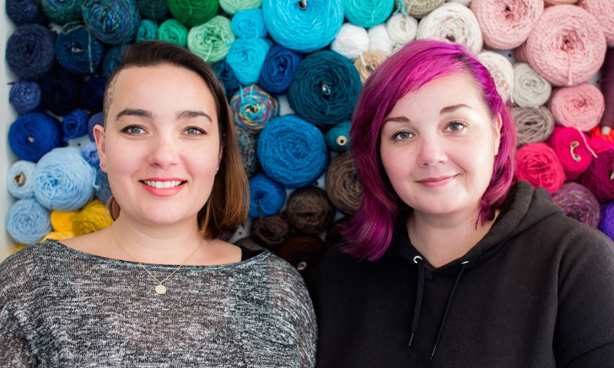
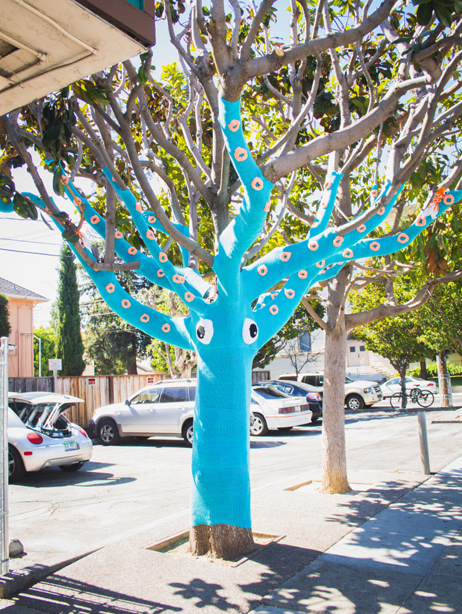
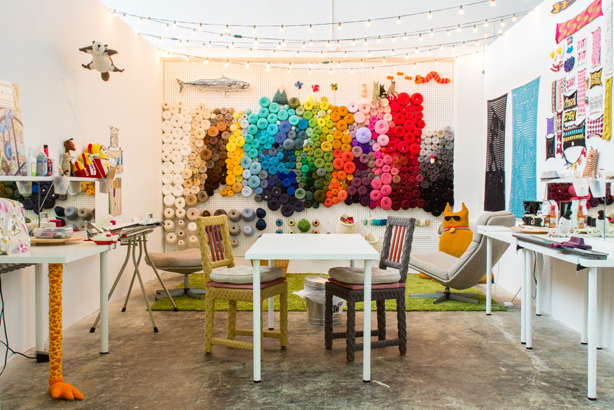
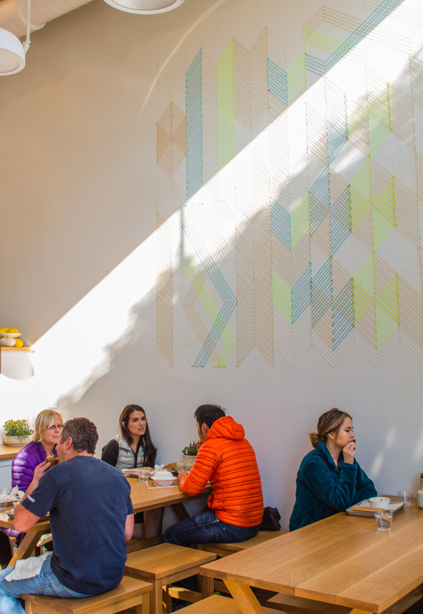
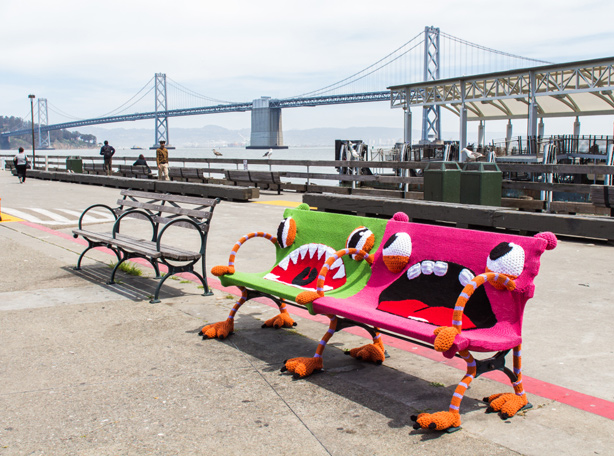
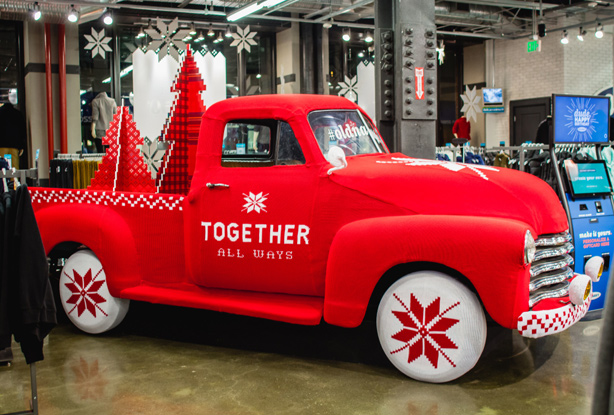
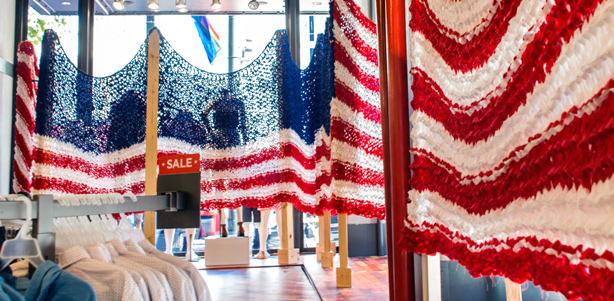
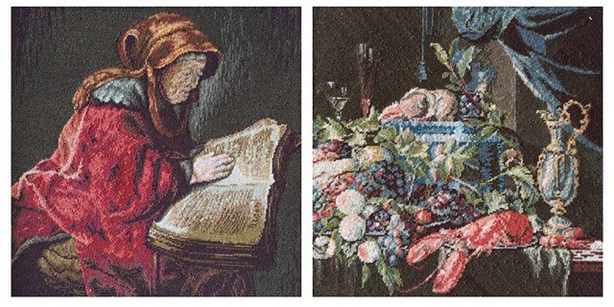
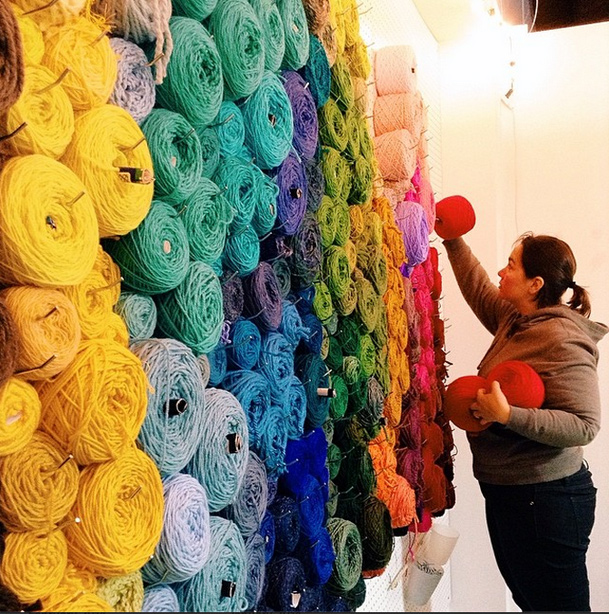
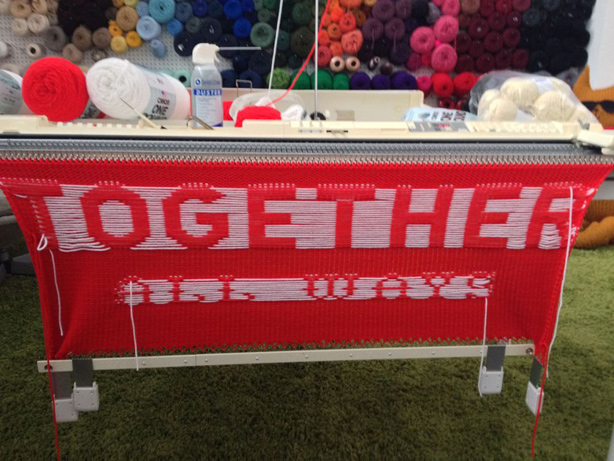
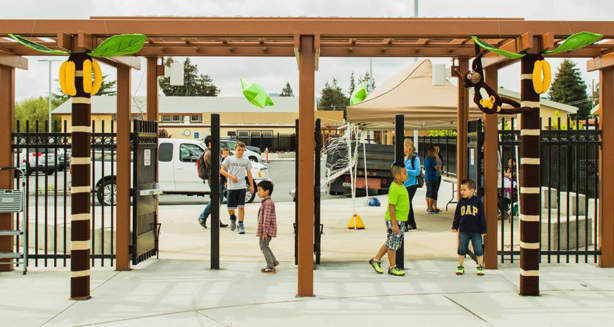
Great interview! Always love to see what Lorna and Jill create! I’m never disappointed by what amazing designs they come up with.
I also loved the back and forth conversation the interview was and I’m always interested in hearing creators origin stories!
Thanks for this Anna!
What a WONDERFUL interview!! These gals have talent in their veins and their installations are terrific!! I’d love to see a collaboration with you, Anna!